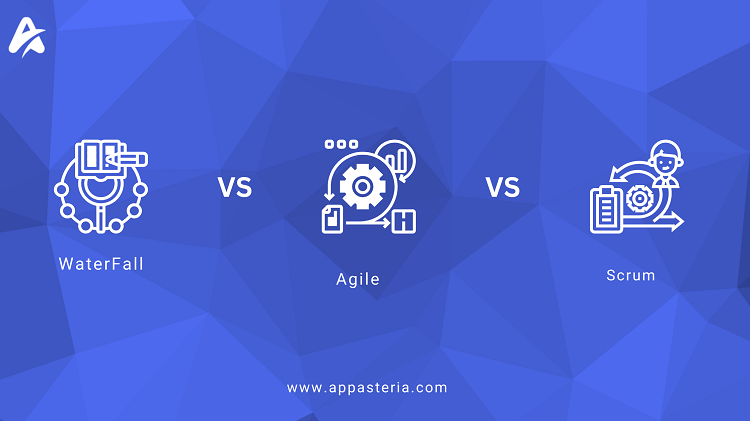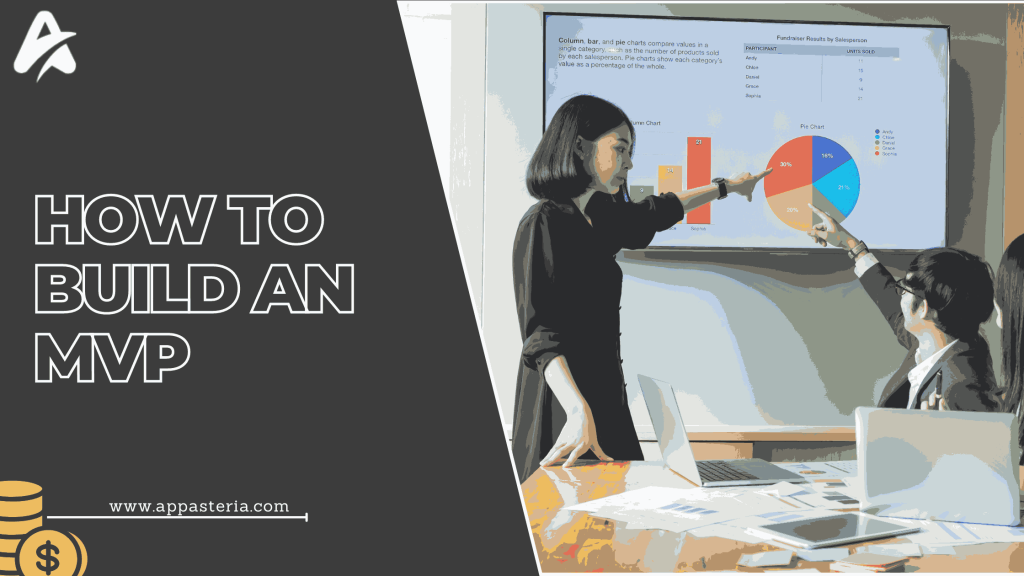The technology industry is teeming with complex vocabulary and convoluted ideas that can be difficult to understand and may overwhelm your mind. Terms such as Waterfall, Scrum, and Agile may be unfamiliar to you, but don’t worry—our team of skilled tech experts at Appasteria are here to help clarify the distinctions between these crucial stages of the development process so that you can stay informed. So, let’s begin with the main topic, “Waterfall vs. Agile vs. Scrum.”
What is The Waterfall Method?
The Waterfall method is a linear software development process. Each development phase (planning, design, development, testing, and deployment) is completed before moving on to the next step. The Waterfall model is called a “waterfall” because each phase flows into the next sequentially, similar to how water flows over a waterfall.
In the Waterfall method, a different team or department typically carries out each development phase. There is little room for changes or adjustments once a step is completed. This model works well for projects with well-defined requirements and limited scope. Where the end goal is clear, and there are few unknowns.
However, one of the limitations of the Waterfall method is that it can be rigid and inflexible in cases where changes are required. Because each phase must be fully completed before moving on to the next, it can be difficult and expensive to make changes once development has progressed beyond a certain point. As a result, the Waterfall model is less suited to projects with evolving requirements or where there is a need for rapid, incremental delivery.
Methodology:

The waterfall method is a linear software development process that follows a fixed sequence of stages, which includes the following:
Requirements gathering and analysis:
In this phase, the requirements for the project are collected and documented, and the goals and objectives of the project are established.
Design:
The design phase involves creating a plan for developing the software, including its architecture, system components, and user interfaces.
Implementation:
In this phase, the software is developed using the plan created in the design phase.
Testing:
The testing phase is where the software is evaluated to ensure. It functions as expected, meets the requirements, and is error-free.
Deployment:
Once the software has been tested and approved, it is deployed to end users.
Maintenance:
The final phase of the Waterfall method is the maintenance phase. Where any issues or bugs that arise after deployment are addressed. And any necessary updates or improvements are made to the software.
It’s important to note that the Waterfall method is a rigid and sequential process, meaning every step must be completed before moving on to the next. There is little room for changes or modifications once an action is completed.
What is the Agile Method?
The agile method is a project management framework that emphasises flexibility, collaboration, and rapid iteration in software development. The Agile approach is based on a set of values and principles outlined in the Agile Manifesto, which emphasises:
- Individuals and interactions over processes and tools.
- Working software over comprehensive documentation.
- Customer collaboration over contract negotiation.
- Responding to change over following a plan.
Overall, the Agile methodology provides a flexible, customer-focused approach to software development that can help teams deliver better products faster. The agile methodology emphasises frequent communication and feedback between developers, stakeholders, and customers to deliver working software quickly and continuously improve the product. Agile teams typically work in short development cycles, called sprints, that last from one to four weeks, and they use various tools and practices such as daily stand-up meetings, user stories, and sprint reviews to help them stay on track and adapt to changing requirements. Some popular software supporting the Agile approach are Jira, Asana, Trello, etc.
Also, Read ( How to Build an MVP )
The Steps in the Agile Methodology Can Vary Depending on the Specific Framework Used, But Generally, the Following are the Key Steps:
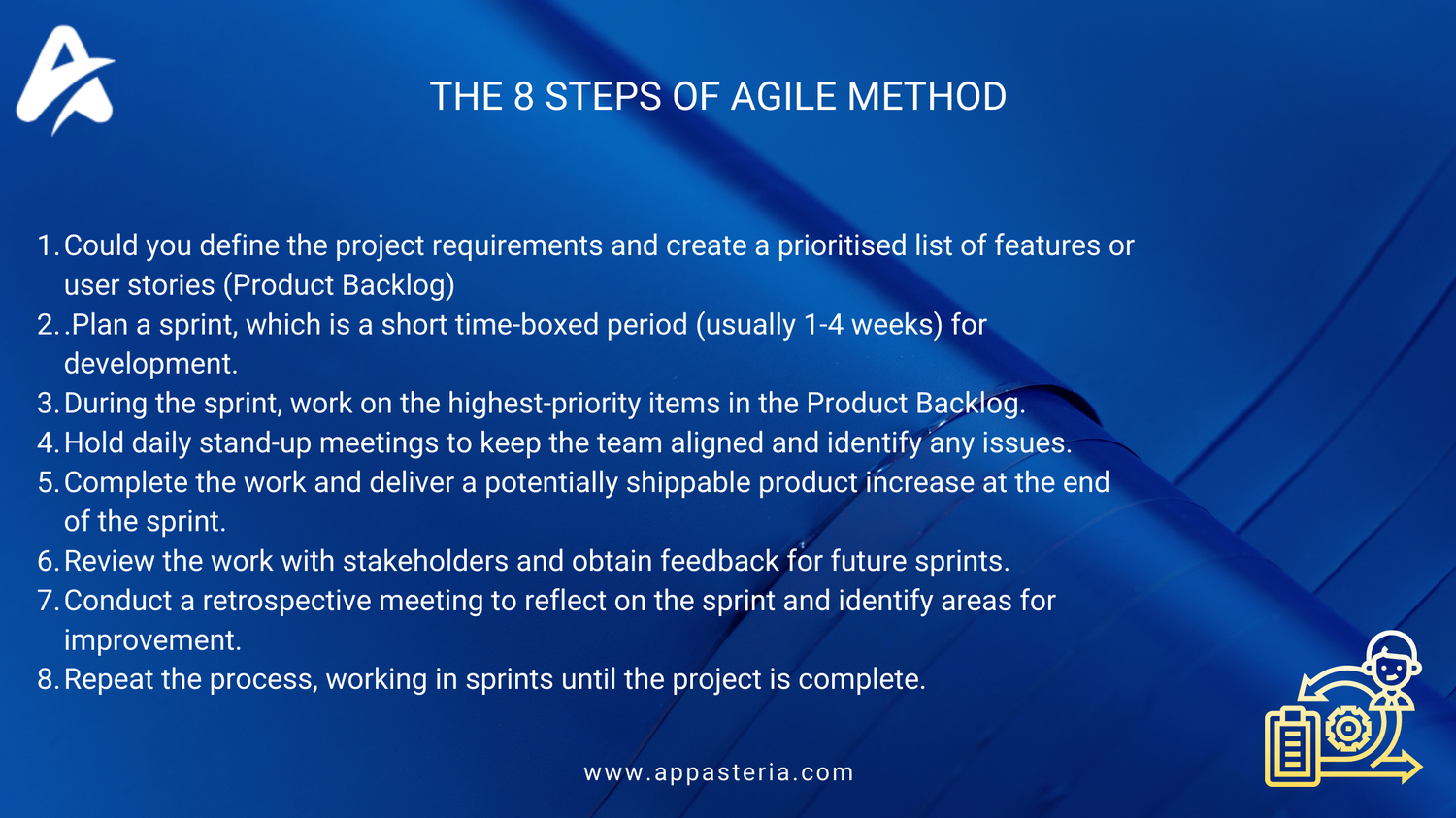
- Could you define the project requirements and create a prioritised list of features or user stories (Product Backlog)
- Plan a sprint, which is a short time-boxed period (usually 1-4 weeks) for development.
- During the sprint, work on the highest-priority items in the Product Backlog.
- Hold daily stand-up meetings to keep the team aligned and identify any issues.
- Complete the work and deliver a potentially shippable product increase at the end of the sprint.
- Review the work with stakeholders and obtain feedback for future sprints.
- Conduct a retrospective meeting to reflect on the sprint and identify areas for improvement.
- Repeat the process, working in sprints until the project is complete.
The Agile methodology emphasises frequent communication and collaboration, continuous improvement, and delivering working software quickly and iteratively.
What is The Scrum Method?
Scrum is an Agile framework for organising and completing complex projects, particularly in software development. It is a lightweight, iterative, incremental approach to project management, emphasising transparency, inspection, and adaptation.
The Scrum Framework Consists of Three Roles:
- The Product Owner is responsible for describing and prioritising the product backlog, the project’s list of features and requirements.
- The Development Team brings product growth at the end of each sprint. The Development Team is self-organising, cross-functional, and works collaboratively to create the deliverables.
- The Scrum Master facilitates the process and ensures the team follows the Scrum framework.
The Scrum Framework Also Includes a Set of Ceremonies, Time-boxed Events that Help Ensures the Team is Aligned and Progressing Towards the Sprint Goal. These Ceremonies Include:
- Sprint Planning: A meeting at the beginning of the sprint, where the team decides what work they will commit to completing during the sprint.
- Daily Scrum: A brief meeting is held each day, where team members share progress updates and discuss any issues that may impede progress.
- Sprint Review: A meeting at the end of the sprint, where the team demonstrates the work they have completed and receives feedback from stakeholders.
- Sprint Retrospective: A meeting at the end of the sprint, where the team reflects on their performance and identifies opportunities for improvement.
The Scrum framework emphasises continuous improvement, collaboration, and flexibility and is often used in Agile software development projects.
Also, Read (Process of Mobile App Development )
Scrum Vs Waterfall
Scrum and Waterfall are two popular project management methodologies used in software development. Here are some critical differences between the two:
- Project structure: Waterfall follows a linear sequential approach to project management, where each phase must be completed before moving to the next. In contrast, Scrum is an agile methodology that follows an iterative and incremental approach, where work is done in sprints.
- Flexibility: Waterfall is a more rigid methodology and requires a well-defined set of requirements at the start of the project. Scrum is more flexible and allows for changes and adjustments during the project.
- Team roles: In Waterfall, each team member has a defined role and responsibility. There are three prominent parts in Scrum: the Product Owner, the Scrum Master, and the Development Team. The Development Team is cross-functional and self-organising.
- Communication: Waterfall emphasises documentation and requires detailed specifications and documentation at every project stage. Scrum, however, emphasises face-to-face communication and collaboration between team members.
- Testing: Waterfall usually has a testing phase that occurs after development is complete. In Scrum, testing is integrated throughout the story and occurs within each sprint.
- Timeframe: Waterfall projects typically have a fixed timeline, while Scrum projects are broken down into sprints, with each sprint having a fixed time-box.
In summary, Waterfall is a traditional, linear approach to project management, while Scrum is an agile methodology designed for flexibility and adaptability. The option between the two depends on the particular needs of the project and the organisation.
Waterfall Vs Agile Vs Scrum
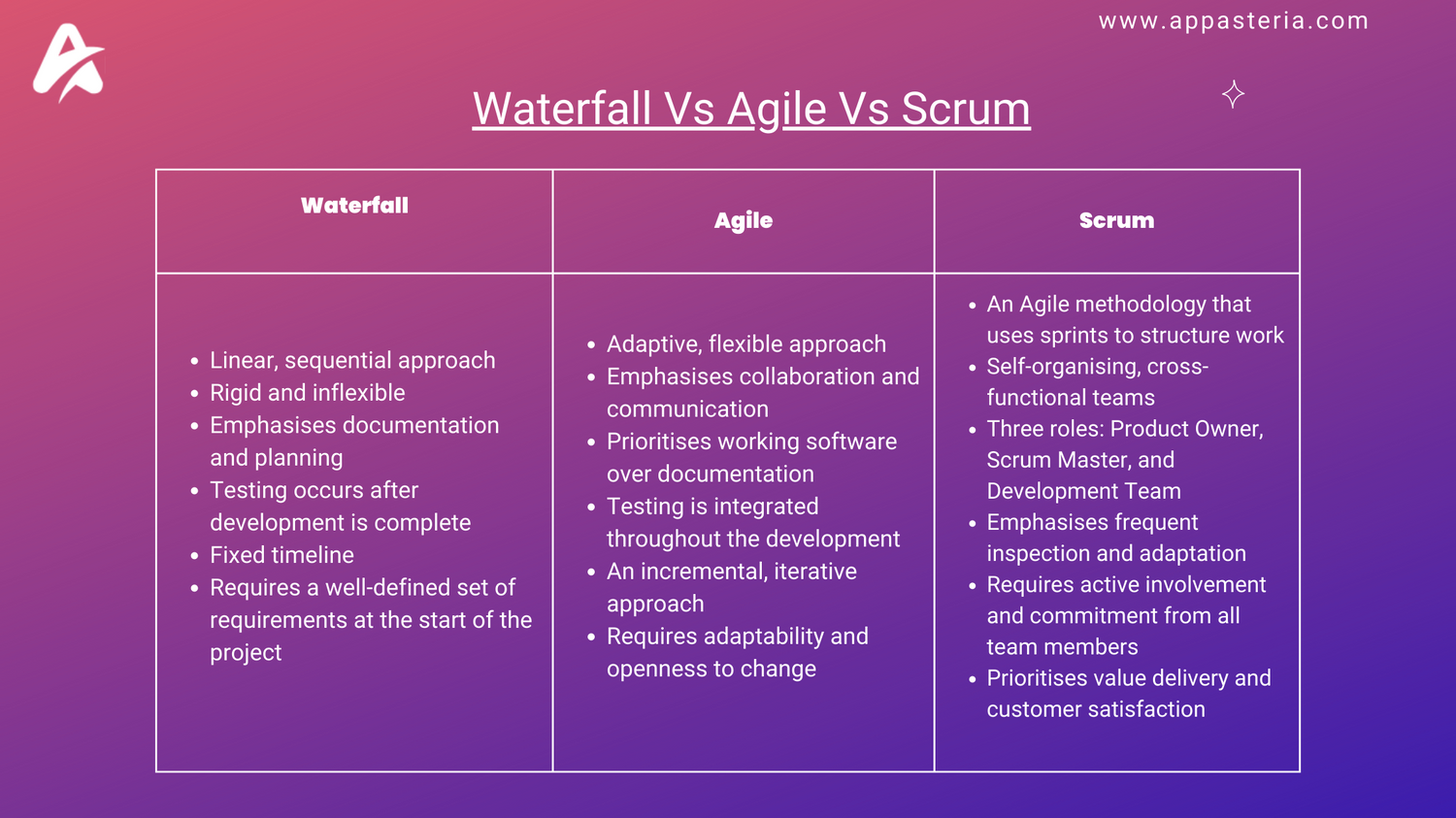
Waterfall, Agile, and Scrum are project management methodologies used in software development. Here’s a brief comparison:
Waterfall:
- Linear, sequential approach
- Rigid and inflexible
- Emphasises documentation and planning
- Testing occurs after the product is complete
- Fixed timeline
- Requires a well-defined set of requirements at the start of the project
Agile:
- Adaptive, flexible approach
- Emphasises collaboration and communication
- Prioritises working software over documentation
- Testing is integrated throughout the development
- An incremental, iterative approach
- Requires adaptability and openness to change
Scrum:
- An Agile methodology that uses sprints to structure work
- Self-organising, cross-functional teams
- Three roles: Product Owner, Scrum Master, and Development Team
- Emphasises frequent inspection and adaptation
- Requires active involvement and commitment from all team members
- Prioritises value delivery and customer satisfaction
Which Project Management Method Should You Choose?
The choice of project management methodology—Agile, Waterfall, or Scrum—depends on various factors. Such as the nature of the project, the organisation’s culture, and the team’s capabilities. Here are some reflections to help you decide which methodology to choose:
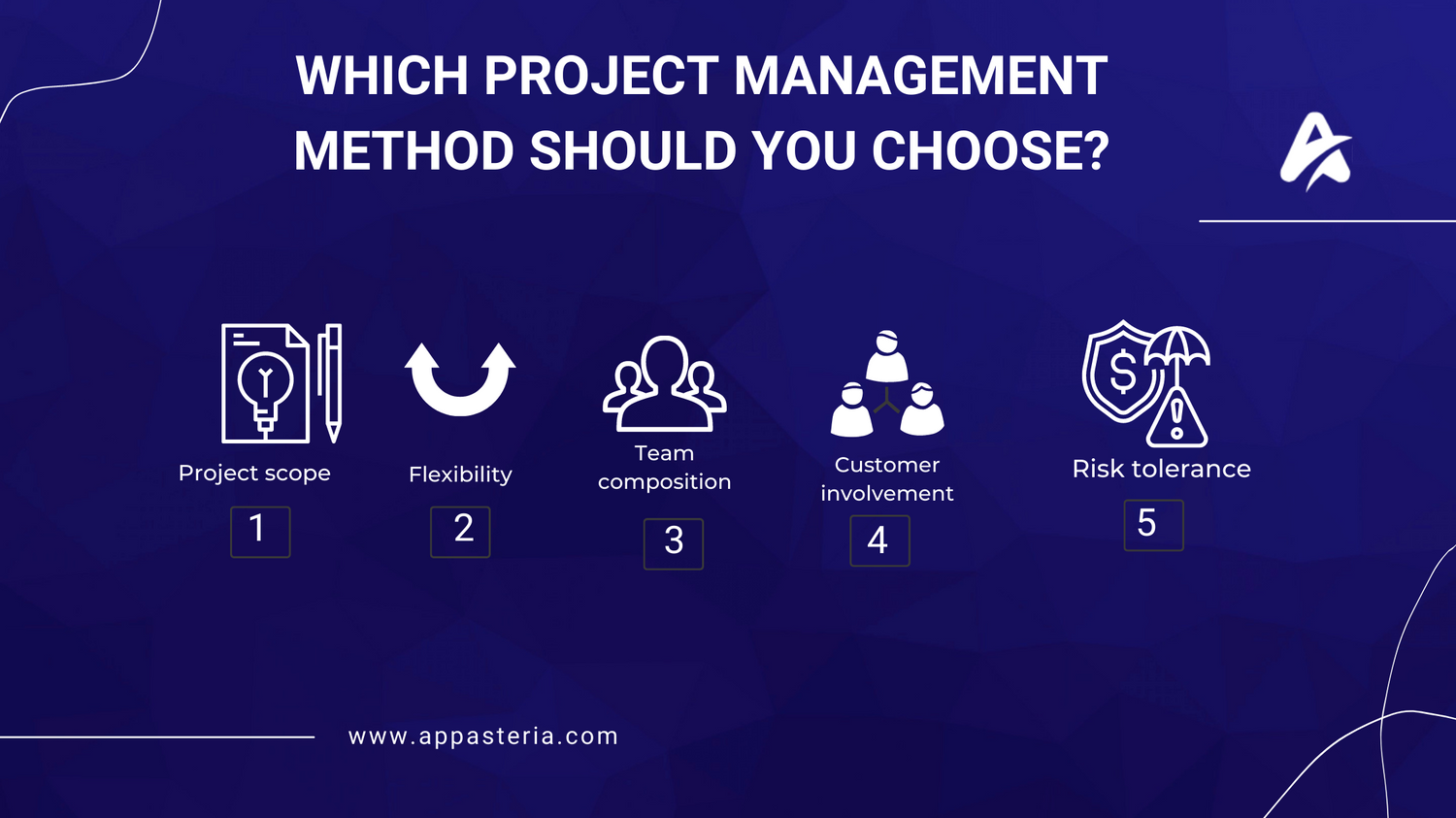
- Project scope: Agile or Scrum might be the methodology for smaller, less complex projects. Whereas, for large, complex projects with a well-defined scope, Waterfall might be more appropriate.
- Flexibility: If the project requires flexibility and the ability to adjust courses frequently, Agile or Scrum may be a better fit. If the project has a well-defined scope and timeline, and any changes are unlikely, Waterfall may be a better choice.
- Team composition: Scrum might be the most suitable methodology for a self-organising, cross-functional team. At the same time, Waterfall may be a better fit for a team that works in a more traditional, hierarchical structure.
- Customer involvement: If customer involvement is a vital aspect of the project, Agile or Scrum might be the best option. These methodologies emphasise collaboration and communication with stakeholders.
- Risk tolerance: If the project carries a high risk, Waterfall may be more appropriate as it requires thorough planning and documentation.
Ultimately, the choice of methodology will depend on the specific needs of the project, the team’s capabilities, and the organisation’s culture. Combining elements of different methods to create a hybrid approach best suits your project is also possible.
Also, Read ( Food Delivery App Development )
Conclusion:
Selecting the appropriate project management methodology for your organisation is crucial. It can significantly influence your product’s outcome and organisational objectives’ attainment. Commonly used methods such as Agile, Waterfall, and Scrum can enhance development. But understanding their unique characteristics and similarities can help you choose the most suitable approach for your company.
FAQs:
What is the main difference between Waterfall and Agile project management methodologies?
The main difference between Waterfall and Agile methodologies is that Waterfall follows a linear and sequential approach to project management, while Agile is iterative and adaptive. Waterfall requires detailed planning, documentation, and a defined set of requirements before starting a project, while Agile allows for changes and adaptations to be made throughout the development process.
What is Scrum, and how is it different from Agile and Waterfall?
Scrum is an Agile methodology that follows an iterative and incremental approach to project management. It uses sprints to structure work and involves self-organising, cross-functional teams collaborating closely to deliver value in short iterations. Scrum is different from Waterfall in that it is adaptive and flexible and different from Agile in that it has a specific set of roles and ceremonies.
What are the advantages of using Agile over Waterfall?
Agile offers several benefits over Waterfall, such as greater flexibility, the ability to adapt to changes and feedback, a focus on delivering working software early and often, and improved collaboration and communication between team members.
What are the disadvantages of using Waterfall project management?
Some of the disadvantages of Waterfall include its rigidity and inflexibility, the need for more adaptability to changes, the high level of documentation and planning required, and the risk of delivering a product that does not meet customer needs.
How does Scrum differ from other Agile methodologies?
Scrum is a specific Agile methodology that emphasises iterative and incremental development, self-organising teams, and particular roles such as the Product Owner, Scrum Master, and Development Team. Scrum differs from other Agile methodologies in its focus on delivering value in short iterations and on team collaboration and communication. It uses sprints to structure work and has specific ceremonies like the Daily Scrum, Sprint Review, and Sprint Retrospective.

